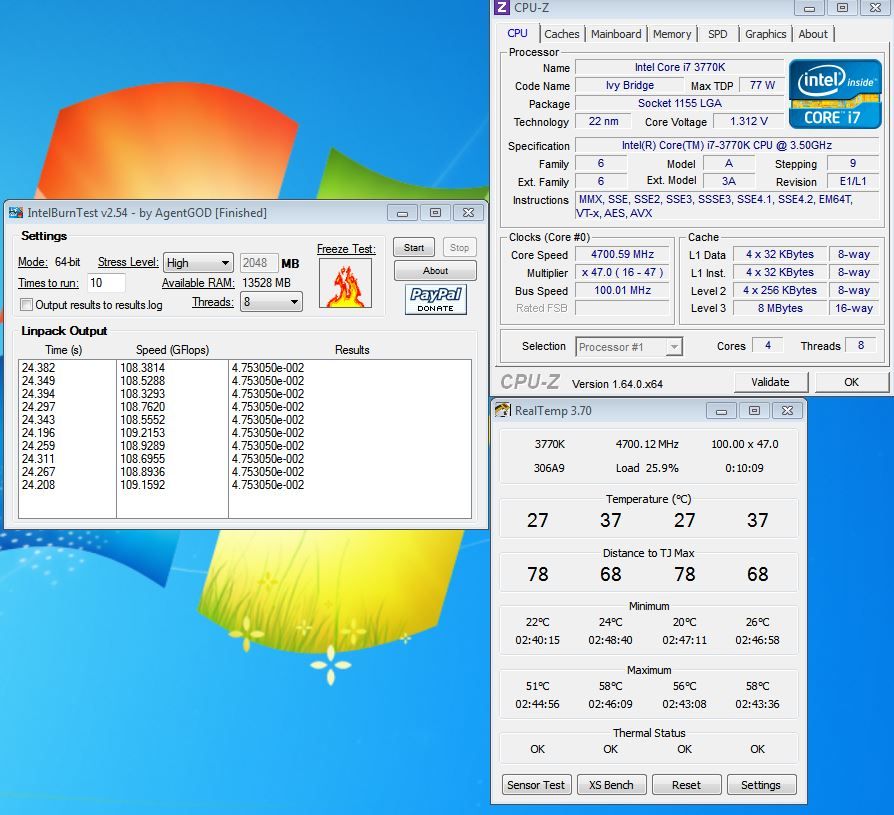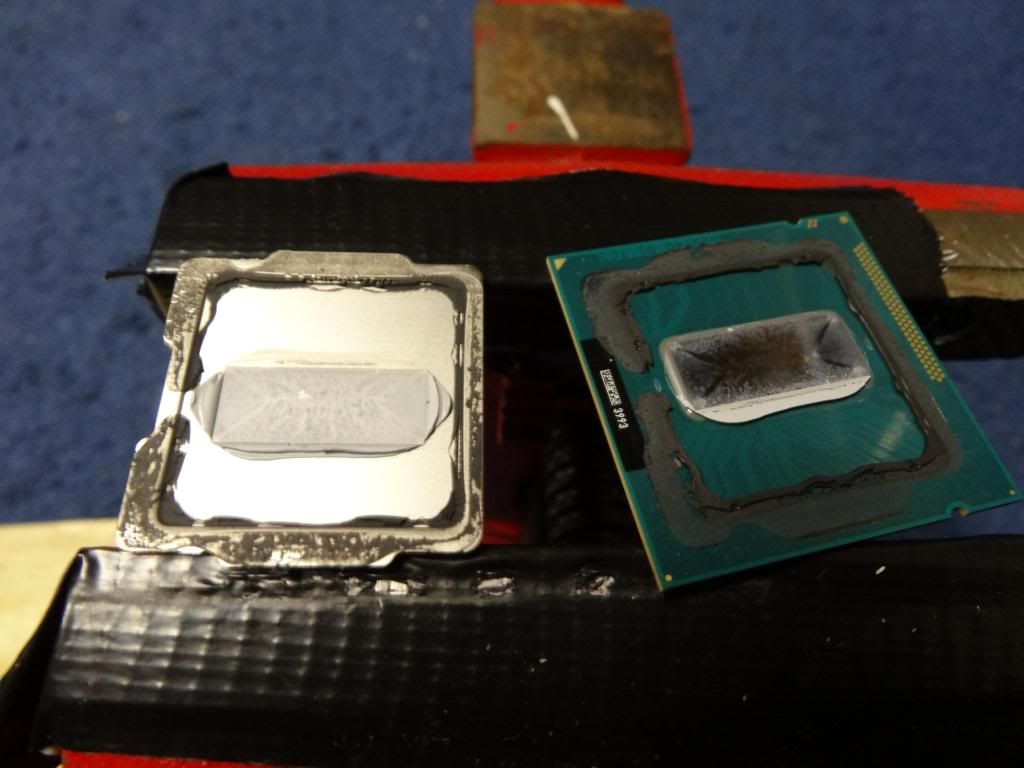jamesriley94
New member
I had nothing to do yesterday, so I decided to play around and de-lid my processor, and replace the thermal paste with NT-H1.
If any of you aren't familiar with this - In previous generations, Intel have soldered the IHS to the processor, allowing for better heat transfer between the processor itself, and the IHS. With Ivybridge however, they decided to use thermal compound (and a cheap one at that) between the IHS and the processor. This resulted in higher temperatures at high overclocks than previous versions - ie - Sandybridge.
If you want to do this yourself, you need to cut the glue around the heatsink with a razorblade or very sharp knife - but I'd advise you watched a youtube tutorial on how to do it, as it will be easier to follow than any guide I could produce on here.
Now, considering every chip is different, along with the choice of thermal paste you use, and even more so with watercooling, my results will never be reflected on other's systems (if any of you do try to do this). So I'd probably say this was more for information of what to expect, as there isn't really a proper guide, or any information for that matter on OC3D.
Test set up:
Parts: Switch 810, Asus P8Z77-v Deluxe, GTX670, AX850, 8gb Mushkin Blackline 1600mhz
Cooling: Alphacool UT60 360mm,Laing D5, XSPC Raystorm CPU block, XSPC Raystorm 680 GPU Block
Fans on the radiator are Silverstone AP121 in push/pull.
I did a number of tests, at different overclocks, different fan speeds, and also disabled the GPU on the majority of tests so I could reach higher overclocks, to see what different the de-lid makes at the higher levels.
I ran Prime95 for half an hour (certain tests recorded at different stages between that too)
So to start of, at stock clocks (3.5ghz (Turbo 3.9ghz)) with core voltage at 1.025v - fans at 12v, pump at speed 5 - with GPU disabled:

Then, at 4.5ghz, core voltage at 1.205v - fans at 5v, pump at speed 1 - GPU enabled:

Next, 4.6ghz, 1.325v, fans at 12v, with the pump at max speed - GPU disabled

Lastly, 4.8ghz, 1.4v, fans and pump at max speeds - GPU disabled:

Temperatures were measured with HWmonitor, and represent each individual core of the 3770k.
Ambient temperatures were roughly the same - don't have equipment to measure properly, however.
So, to conclude, the de-lid has definitely made a difference to temperatures. Whether it's worth the risk is another question though.
I will say as I was running out of thermal paste, I probably haven't done the best job on applying it, so temps may even be a little lower in the de-lid conditions.
As others across the internet have reported 20 degrees Celsius drops in temperatures, I've definitely not experienced that. But, I do think the differences are significant.
The actual process isn't particularly easy to do. Mine required a lot of effort to pry off the IHS, and trying to wiggle the blade, or lever underneath it only resorted in damaging the PCB. But as long as you're relatively careful, I personally don't think there's much risk involved in doing it.
Also, going from my results, there's more of a benefit in doing this as you push the CPU more and more. So I don't really see much point in it unless you are pushing for the highest overclock possible.
Overall, I wouldn't expect doing this to massively reduce your temps. But, if you think it's worth the effort, and have a backup plan if things go wrong, then I'd recommend doing it. The latter tests showed around a 10 degree drop in temps, which is still pretty significant. So if you want an extra hundred mhz or so on an overclock, then this is something to consider.
If any of you aren't familiar with this - In previous generations, Intel have soldered the IHS to the processor, allowing for better heat transfer between the processor itself, and the IHS. With Ivybridge however, they decided to use thermal compound (and a cheap one at that) between the IHS and the processor. This resulted in higher temperatures at high overclocks than previous versions - ie - Sandybridge.
If you want to do this yourself, you need to cut the glue around the heatsink with a razorblade or very sharp knife - but I'd advise you watched a youtube tutorial on how to do it, as it will be easier to follow than any guide I could produce on here.
Now, considering every chip is different, along with the choice of thermal paste you use, and even more so with watercooling, my results will never be reflected on other's systems (if any of you do try to do this). So I'd probably say this was more for information of what to expect, as there isn't really a proper guide, or any information for that matter on OC3D.
Test set up:
Parts: Switch 810, Asus P8Z77-v Deluxe, GTX670, AX850, 8gb Mushkin Blackline 1600mhz
Cooling: Alphacool UT60 360mm,Laing D5, XSPC Raystorm CPU block, XSPC Raystorm 680 GPU Block
Fans on the radiator are Silverstone AP121 in push/pull.
I did a number of tests, at different overclocks, different fan speeds, and also disabled the GPU on the majority of tests so I could reach higher overclocks, to see what different the de-lid makes at the higher levels.
I ran Prime95 for half an hour (certain tests recorded at different stages between that too)
So to start of, at stock clocks (3.5ghz (Turbo 3.9ghz)) with core voltage at 1.025v - fans at 12v, pump at speed 5 - with GPU disabled:

Then, at 4.5ghz, core voltage at 1.205v - fans at 5v, pump at speed 1 - GPU enabled:

Next, 4.6ghz, 1.325v, fans at 12v, with the pump at max speed - GPU disabled

Lastly, 4.8ghz, 1.4v, fans and pump at max speeds - GPU disabled:

Temperatures were measured with HWmonitor, and represent each individual core of the 3770k.
Ambient temperatures were roughly the same - don't have equipment to measure properly, however.
So, to conclude, the de-lid has definitely made a difference to temperatures. Whether it's worth the risk is another question though.
I will say as I was running out of thermal paste, I probably haven't done the best job on applying it, so temps may even be a little lower in the de-lid conditions.
As others across the internet have reported 20 degrees Celsius drops in temperatures, I've definitely not experienced that. But, I do think the differences are significant.
The actual process isn't particularly easy to do. Mine required a lot of effort to pry off the IHS, and trying to wiggle the blade, or lever underneath it only resorted in damaging the PCB. But as long as you're relatively careful, I personally don't think there's much risk involved in doing it.
Also, going from my results, there's more of a benefit in doing this as you push the CPU more and more. So I don't really see much point in it unless you are pushing for the highest overclock possible.
Overall, I wouldn't expect doing this to massively reduce your temps. But, if you think it's worth the effort, and have a backup plan if things go wrong, then I'd recommend doing it. The latter tests showed around a 10 degree drop in temps, which is still pretty significant. So if you want an extra hundred mhz or so on an overclock, then this is something to consider.





